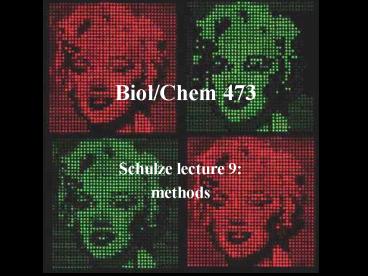BiolChem 473 - PowerPoint PPT Presentation
1 / 35
Title:
BiolChem 473
Description:
Fractionate by electrophoresis in an agarose gel. Transfer by capillary action to membrane (blot) ... probe to Southern Blot. Prehybridization step: blocking ... – PowerPoint PPT presentation
Number of Views:56
Avg rating:3.0/5.0
Title: BiolChem 473
1
Biol/Chem 473
Schulze lecture 9 methods
2
Southern Analysis
- Extract DNA
- Fractionate by electrophoresis in an agarose gel
- Transfer by capillary action to membrane (blot)
- Incubate with nucleic acid probe
- Detect analyze collect Nobel Prize
3
Gel Treatment Measurements and photography
Photograph of genome digest under UV
Agarose gel with genome digest in it
4
Set up the SOUTHERN BLOT transfer (denatured!
Ie., single stranded!) DNA from agarose gel to
membrane
5
Making a Probe
- cDNA, genomic fragment, PCR product etc.
- Repeat for RFLP analysis
- Copy of mRNA (cDNA) to analyze gene structure
- Choose a detectable label
- Radioactivity (usually P32)
- bumpy groups like DIG
- Incorporate label into probe
- Random prime labeling
- Nick translation
6
A cDNA is a copy of a mRNA
7
Hybridizing probe to Southern Blot
- Prehybridization step blocking
- Block off parts of the membrane not already bound
with nucleic acid - Hybridization step stringency can be varied
- High salt solution promotes strong pairing
between probe and target - High temperature increases specificity of probe
- Posthybridization step washing off excess probe
- Temperature, salt concentration again can be
varied for purposes of stringency
8
Application Transgene integrity and copy number
(Reza Imani)
HindIII digest indicates whether transgene is
intact
XhoI digest indicates transgene copy number
9
Northern Analysis
- Extract RNA
- Fractionate by electrophoresis in a denaturing
agarose gel - Transfer by capillary action to membrane (blot)
- Incubate with nucleic acid probe
- Detect analyze collect Nobel Prize
10
RNA gels
11
Application Developmental Northern
12
Microarrays
- Just like in Northern and Southern analysis, this
technique relies on HYBRIDIZATION between
complementary sequences - Analyze gene expression of all the genes in the
genome AT ONCE by representing probes for every
gene on a small glass chip, and incubating the
chip with labeled target RNA
13
Two kinds of microarrays
- Spotted arrays presynthesized single or double
stranded sequences (probes) are printed onto
glass slides - Probes are generally fairly long
- several hundred base pairs or more
- Each experimental trial requires ONE array chip
- oligonucleotide arrays sets of oligos
(probes) representing a particular gene
sequence are synthesized directly onto the
surface of glass wafers - Probes are short usually about 25 nucleotides
- long each gene is represented by a set of
25mers. - Each experimental trial requires TWO array chips
14
Robotic microarray production (Spotted arrays)
www.bio.davidson.edu/.../ CSU/Introscanners.html
15
Spotted Array 1. RNA isolation
16
Spotted Array 2. Generate labeled cDNAs
17
Spotted Array 3.Hybridize both cDNA pools to a
single microarray chip
Pool labeled cDNAs
18
Spotted Array 3.Hybridize both cDNA pools to a
single microarray chip
19
Spotted Array Assay 4. scan chip
20
Pat Brown, father of glass slide microarrays
Stanford University
21
Oligonucleotide arrays build up probes DIRECTLY
on chip surface
22
Oligo array hybridization and scanning
23
Expression in sample 1
24
Expression in sample 2
25
(No Transcript)
26
Microarray Application tumor expression profiles
critical invasive melanoma samples supplied by U.
of Iowa lab!
patient samples
gene names
Nature 406 536-540 (2000)
27
RTPCR (Real-Time PCR or Q (quantitative) PCR)
- mRNA is converted into DNA via reverse
transcriptase (RT). - The polymerase chain reaction (PCR) uses specific
primers to make multiple DNA copies. - Measure amount at end of cycle
28
Application Microarray RTPCR
29
Chromatin immunoprecipitation
- Used to determine whether a given protein binds
to a given DNA sequence in vivo - Like all protein analysis involving antibodies
(including westerns) a specific antibody is
required - If there is no specific antibody, then epitope
tagging can be employed (FLAG, MYC, HIS) - An epitope is a portion of a molecule to which an
antibody binds
30
Antibodies as probes
31
Back to the Chromatin Immunoprecipitation Assay
(ChIP)
32
The probes on microarrays can be complementary to
the entire genome!
33
The probes on microarrays can be complementary to
the entire genome!
34
ChIP on ChipChromatin immunopreciptation on a
microarray Chip
DNA from binding site
Fluorescently label
http//www.chiponchip.org/
35
Application where on the chromosomes does the
male-specific lethal-3 protein bind?































